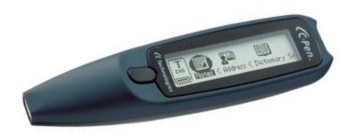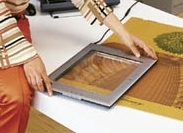Time-saving tools for writing
I'm just
about to start the third volume in my
TRENT series, so my thoughts are
partly
on how to save time in the writing process. Here are my best tips.
The best
bit comes first - if you do nothing else, get the InsertBible tool.
1) InsertBible tool
2) Pen
Scanner
3) Summary and Bibliography
4) Speed tips for
Word
1) InsertBible
tool
Michael Stead unveiled a wonderful new tool at the
Tyndale Fellowship conference.

It inserts a Bible verse or passage into a Word
document in several versions:
* ESV (including footnotes in curly brackets)
& RSV
* MT (corrected BHS, plain, or pointed or with full Masoretic
markings)
* NA27 (same as NA26 and UBS3/4)
* Translitteration of MT &
NA27 Hebrew and Greek (with full accents etc)
* LXX (Rhalf's, I guess, but
Quinta looks as if it will be very similar)
* Vulgate (well, why not? Useful
for historians if no-one else).
* Inserts as a series of paragraphs, or as a
table
* Versification to match the versions used.

This works well in Word 2003, but struggles
elsewhere, even though theoretically
it should be OK in all versions of Word
(we've heard that from MS before!).
The Settings allow you to pick the fonts
to use. I recommend you get Cardo and
use that for them all - it is a
Unicode font which has Hebrew, Greek, transliteration,
and looks good for
English too. Get it as part of the free Tyndale Unicode kit
at
http://www.TyndaleHouse.com/Fonts.htm
He is
offering this to the academic community FREE, and has negotiated free access
for us with the various copyright holders. All we have to do is send a
signed fax
which we can printout from his website at
http://stead.streetlinemedia.com/
This is a
no-brainer if you use Word 2003on a PC. Do it now
(though it is a 12Mb
download, so make sure you are on a fast connection).
If you use Word on a
Mac, just keep badgering MS to bring out a version which works properly with
Unicode.
2) Pen Scanner
When I read
library books, I highlight key phrases with a pen.
Before you call the
Librarian, I'd better add that I use a pen scanner.
Just draw it over a
sentence and the words are ready for your computer.
Note: they only works
for European fonts, not for Greek & Hebrew.
There are several
pen-scanners available.
Some only work when connected to a computer which
runs the software
eg
C
-Pen 20,
Iris
Pen Some work away from the computer (much more convenient), though you
can also link to a computer and insert directly into a document,
eg
C-Pen 600,
C-Pen 800,
Wizcom
Elite or
InfoScanFor
some reason, Amazon appears to be the best place to buy these. Search for "Pen
scanner"

I recommend the C-Pen 600 or 800 (
www.cpen.com) - pricey and hard
to find, but worth it.
The Optical Character Recognition software is very
fast and accurate.
You can add dictionaries, eg German, to give you instant
translations for a word you scan
Note: I find the batteries drain, so I flip
up one end of the batteries when not in use.
If you want to scan lots of
text, you need a flatbed scanner. I recently saw someone using
the wonderful
HP ScanJet 4670, which is like a piece of glass you place on top of a
book.
Much faster than constantly turning the book over in order to turn to
the next page.
 3) Summary and
Bibliography
3) Summary and
Bibliography
You were probably told this at Junior school:
Write summaries of what you read.
And add page numbers - you know how much
time this would have saved in the past.
I use an endless Word file -
easy to search and copy and edit.
I include full bibliographic details in a
"Heading 2" style (click on Style in the Formatting toolbar)
- then I can
search the bibliography separately from the summaries
(eg click on
"Find" - "More" - "Format" - "Style" - "Heading 2")
- or I can view just the
bibliography data
(eg click on "View" - "Outline", then click on "2"
in the outlining toolbar which appears)
I use Heading 1 for subject areas, so
I can display only the entries in a particular subject.
Or you could put
your summary in your Endnote database, if you find that quicker.
If Endnote
slows down your computer, try adding extra memory.
4) Speed tips for Word
Use abbreviations which
automatically expand as you type
eg when you are writing an article about the
eschatological banquet,
set up an abbreviation ".et" which automatically
expands when you write it:
1) type "eschatological banquet" and highlight it
2) click on "Tools" then on "Auto-correct" and type ".eb" in the Replace
box
3) click on "Add" then "OK" and try it out - just type ".eb" then hit the
spacebar
Note: The abbreviations are case-sensitive, so ".EB" can abbreviate
something different
The abbreviations don't have to start with a dot, but
this works better for various reasons.
Use Styles. They are
powerful and necessary for book-long projects.
- turn on the Style area so
you can see what you are doing
(click on "Tools", "Options", "View"
and type "0.5" in the "Style Area Width")
- to format or create a style,
double-click on the name in the left-hand Style Area.
- Click on "View" -
"Normal" to see the style area, or "View" - "Print" to hide it
- assign a
style for chapter headings and paragraph headings, paragraphs & quotes,
- apply them rigorously and try to avoid adding other
formatting
Use exact line spacing
- exact line spacing for
footnotes fixes a bug in Word97 which reappears if someone
accidentally opens and edits your document in Word97. So best to do it for all
documents.
Footnotes can appear on the wrong page or flow wrongly
without this fix.
- to do this, double-click on "Footnote" in the "Style
Area" (see previous note)
then click on "Modify", "Format",
"Paragraph". Select "Line spacing"="Exactly"
- exact spacing also
prevents Hebrew or Greek fonts making a wide line when they are used,
so exact spacing is useful for the main text as well.
Use Unicode
fonts for Greek & Hebrew - this will future-proof your work
- get the
free Tyndale Unicode kit at
http://www.TyndaleHouse.com/Fonts.htm
Use
formatting in Find and Replace
- to find all Italics: click on "Find" and
press Ctrl-I.
- to find all Arial font, click on "Find", "More", "Format",
"Font" and type "Arial"
Use Tracking and Compare Document for
editing
- click on "Tools", "Track changes" to mark changes as you make
them
- another person can quickly find them, and accept or reject them.
-
if tracking has not been used, to compare an edited text with the
original,
click on "Tools", "Compare" and find the other
document.
(Note: it is best to use a copy of your document when
comparing with another)
Indexing - follow the instructions at
http://www.TyndaleHouse.com/TTech/TTech006.htm
Use
Tables instead of columns, then make the lines invisible
- tables give
you much more freedom for formatting and
editing



